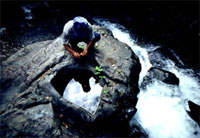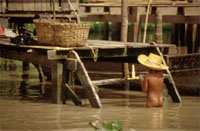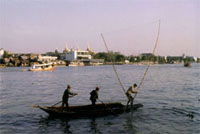| |
| Introduction to Thailand Reflected (excerpt) |
 |
River Unrivalled
 It is impossible
to overestimate the Chao Phya's vital role in Thailand's history,
economy, and culture. That importance is underscored by the contention
by many scholars that Siam - the name by which Thailand was known
until the middle of the 20th century - translates as "people of
the river", the "river" denoted being the Chao Phya. It is impossible
to overestimate the Chao Phya's vital role in Thailand's history,
economy, and culture. That importance is underscored by the contention
by many scholars that Siam - the name by which Thailand was known
until the middle of the 20th century - translates as "people of
the river", the "river" denoted being the Chao Phya.
The river's significance dates from ancient times, long before cities
and civilizations rose from its banks. When one delves beneath the
surface of Thai society, one quickly discovers the extent to which
its culture is inextricably bound up with water and rivers. Water
is the incubator for rice and fish, the nation's staple foods. It
is the principal element in Thailand's two most important festivals,
Songkran and Loy Krathong, and in its royal and lay rites of passage.
Its soft sensuality pervades the liquid contours of Buddha images,
and the sinuous lines and planes that proliferate in wat (monastery)
architecture and mural paintings.
 The
river also provides an allegory for the Thai mode of negotiating
life's obstacles: it does not confront them, it flows around them.
Thais do not live as independent entities, they blend their lives
together, melding through consensus and compromise to preserve a
liquid continuity whose sur-face, while often masking turmoil and
contradiction, lubricates social interaction. The
river also provides an allegory for the Thai mode of negotiating
life's obstacles: it does not confront them, it flows around them.
Thais do not live as independent entities, they blend their lives
together, melding through consensus and compromise to preserve a
liquid continuity whose sur-face, while often masking turmoil and
contradiction, lubricates social interaction.
The Chao Phya's paramount importance is not immediately evident from a map. Four thin blue veins representing its tributaries are but faint indications of the river's grandeur. As they flow south through craggy gorges, they are augmented by huai, small streams flowing from side valleys which thicken the veins to a semblance of majesty.
 As
this quartet descends from the northern hills into the broad alluvial
Central Plains, two of the rivers meld with the other two. Just
downstream at Nakhon Sawan, the now-engorged twins collide virtually
at right angles. Here, in the heart of the Central Plains, the Chao
Phya River proper begins. As if sensing its ultimate destina-tion,
the meandering river takes a bolder course, its bends flattening
and broadening as it moves towards the sea. Blue ink flows in a
thick band through brown and green until its reaches the country's
vibrant nerve center, Bangkok. A few dozen kilometers below the
kingdom's capital, the line splays to become an aquamarine mass
inscribed "Gulf of Thailand". As
this quartet descends from the northern hills into the broad alluvial
Central Plains, two of the rivers meld with the other two. Just
downstream at Nakhon Sawan, the now-engorged twins collide virtually
at right angles. Here, in the heart of the Central Plains, the Chao
Phya River proper begins. As if sensing its ultimate destina-tion,
the meandering river takes a bolder course, its bends flattening
and broadening as it moves towards the sea. Blue ink flows in a
thick band through brown and green until its reaches the country's
vibrant nerve center, Bangkok. A few dozen kilometers below the
kingdom's capital, the line splays to become an aquamarine mass
inscribed "Gulf of Thailand".
The map's static blue lines provide little hint of the river's character or of its importance in Thai consciousness. Although its shallow gradient militates against thunderous rapids, the Chao Phya is not a passive force, its waters merely bearing Thailand's history to the sea. As the principal shaper of Thai civilization, the river has molded the nation's values, been a life source for its rich agriculture, served as a highway for commerce, linked its cities, and barred its enemies.
A finger sliding down the Ping, Wang, Yom, Nan, and Chao Phya traces the political and economic development of Thailand from its 13th-century inception as a nation to the present day. Over the centuries, successive kingdoms have moved steadily southward along the rivers: the Sukhothai kingdom (1238-1350) near the Yom River in the North, Ayutthaya (1351-1767) on the Chao Phya, Thonburi (1767-1782) on the right bank of the Chao Phya, and Bangkok (1782-present) on the left bank. Most central and northern minor kingdoms were also founded on the shores of the Chao Phya or its affluents.
One also traces Thailand's economic development, beginning with northern slash-and-burn hill-tribe agriculture, passing through the rice paddy cultivation of the Central Plains, and ending in the industrialized cityscape of Bangkok. While other areas of Thailand have moved towards greater prosperity at a more sedate pace, these regions etched by the Chao Phya system have become economic powerhouses and major population centers.
For centuries, the rivers coursed untrammeled, the movements of travelers using them as highways, dictated by the waters' whims. From the 1700s, boatmen poled wooden barges up the Ping River on six-week journeys to Chiang Mai. They timed their return voyages to coincide with the monsoon flows, braving the rapids above Sam Ngao, and then paddling the flatter stretches of the lower river to the sea. Teak logs, a mainstay of 19th-century commerce, were floated down the rivers to Bangkok and from there to the world's cities.
The introduction of steam-driven launches in the late-1800s and diesel-driven boats in the 1900s changed travelers' perceptions of the river. Rather than flowing with it, they subverted the Chao Phya's force to the brawn of powerful engines, using the waterways as mere motive surfaces on which to glide to distant destinations. By the 1970s, the river had all but ceased to serve even that purpose. New highways were constructed far from the rivers and commerce began to stream along them. Far-sighted riparian entrepreneurs relocated their businesses to the towns that began springing up on highway shoulders, consigning the riverbanks to history.
In the 1950s came the dam builders who treated the river, not as a natural entity, but as a component in a progression towards prosperity. Over the next 20 years, engineers would wall portions of the Chao Phya and three of its four tributaries into still ponds in order to light cities, power industries, irrigate crops, and quell floods. The intricate irrigation systems of the North would be aban-doned for gas-powered pumps which sucked water as if from a storage tank. The rivers would become mere ditches to guide or divert the silent waters from their journey through the mountains, ensuring that they would never reach the sea. Like the houses that now face away from the rivers, Thais seemed to have turned their backs on the Chao Phya.
And yet the legend of its greatness persists. Thais refer with pride to the Chao Phya's ancient lineage as the "River of Kings". It is an important psychological conceit which anchors their faith in nationhood, and buoys them in their progress towards material wealth. This belief is now being translated into a new appreciation of the river's value as a natural heritage, one that must be bequeathed in improved form to future generations. It is this belief and the preservation efforts it has spawned that this book celebrates. |
|



